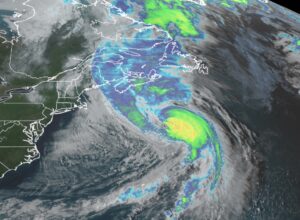
Another entry in the category of unprecedented weather extremes comes from the tropical Atlantic basin where, last week, Hurricane Fiona wrought devastation to the Commonwealth of Puerto Rico, still reeling from its assault by Hurricane Maria eerily precisely five years earlier.
Fiona dropped upwards of 30 inches of rain on the south shores of Puerto Rico before heading north into the Atlantic, where it systematically strengthened into a Category 4 hurricane with sustained winds of more than 130 mph.
As Fiona was strengthening, the weather here in southern Wisconsin underwent a welcome change from the extreme humidity of Monday and Tuesday to the much drier, fall-like conditions of the late part of the week. This change was afforded by the passage of a fairly strong autumn cold front — on the first full day of fall. That same cold front was part of a larger extratropical weather system over eastern North America that was heading eastward to a rendezvous with Fiona as she left the tropics.
Embedded within the extratropical storm was a feature known as a tropopause fold. Such features were first observed only in the mid-1950s and, for a long while thereafter, were thought to be very unusual features, bordering on curiosities. Subsequent work has shown that these folds are ubiquitous features of the mid-latitude flow and, in fact, account for the creation of some of the ingredients needed for the development of all extratropical weather systems.
The fold associated with the storm that cooled us off by Wednesday was unusually strong for this time of year. When it encroached on Fiona north of Bermuda, the combination led to a dramatic reinvigoration of Fiona, as an extratropical cyclone, that slammed into Nova Scotia on Saturday, recording the lowest sea-level pressure ever observed in Canada.
So, for two weeks in a row, the atmosphere has served up remarkable examples of the havoc that can result from vigorous interaction between the tropics and the extratropics.
Steve Ackerman and Jonathan Martin, professors in the UW-Madison department of atmospheric and oceanic sciences, are guests on WHA radio (970 AM) at 11:45 a.m. the last Monday of each month. Send them your questions at stevea@ssec.wisc.edu or jemarti1@wisc.edu.

